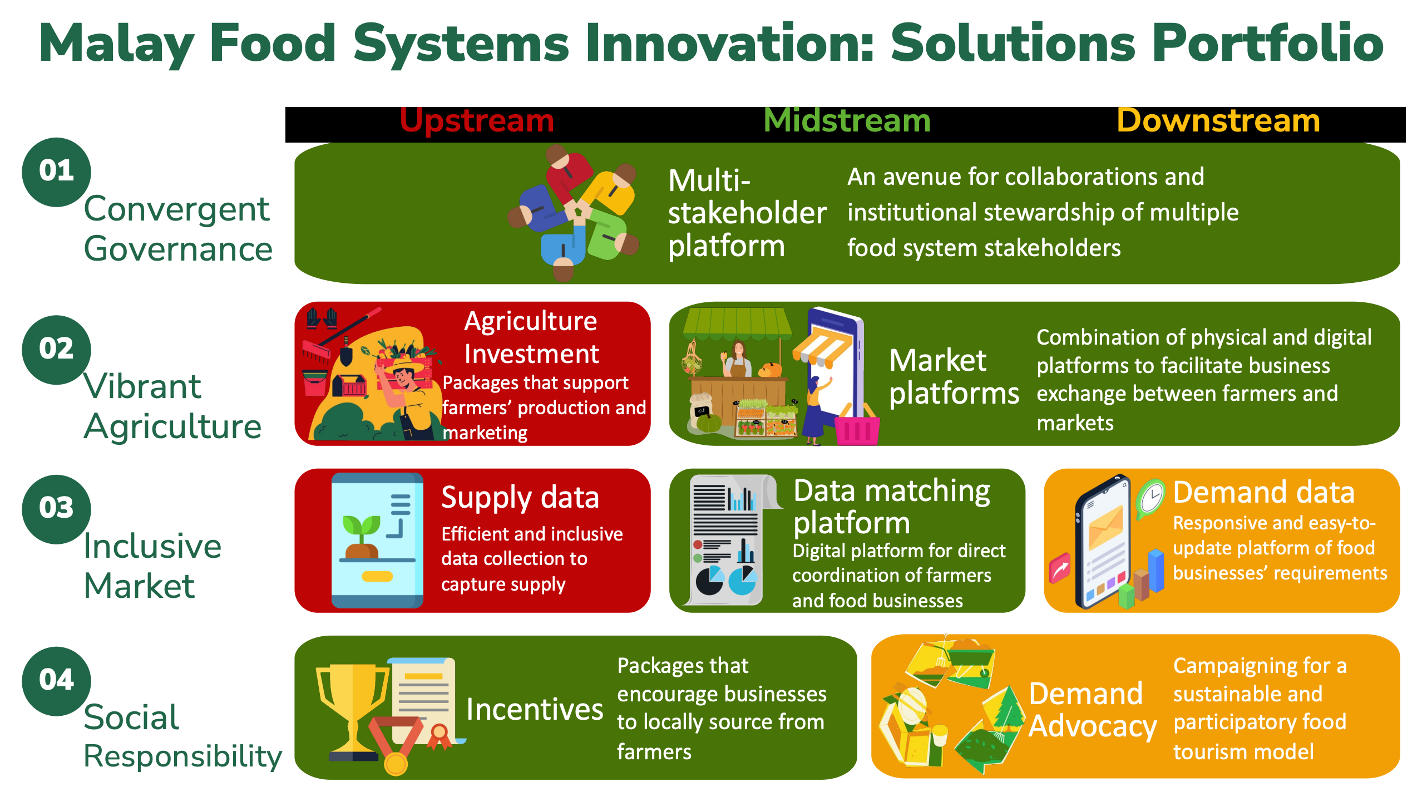Disclaimer:
Please be aware that the content herein has not been peer reviewed. It consists of personal reflections, insights, and learnings of the contributor(s). It may not be exhaustive, nor does it aim to be authoritative knowledge.
Learnings on your challenge
What are the top 5 key insights you generated about your frontier challenge during this Action Learning Plan?
1. With the lockdowns that affected the tourism economy in Malay, the home and gateway to world-renowned tourist destination Boracay Island, locals relied on agriculture and food as the means to survive. Idle lands, which are primarily allocated for tourism purposes, were utilized as community gardens to grow food for consumption. Displaced tourism workers planted vegetables and caught fish. Agriculture was the backup plan, but can it become a new feature of a more resilient local economy? 2. Food businesses have large requirements for high-value vegetables such as lettuce, peppers, cabbage, among others, to be provided to them in a sustainable and consistent manner. There is a high buy-in from the business sector to source locally. But how can local producers be empowered to meet the Mayor's aspirational target of 10-20% of demand for key produce satisfied by local demand? 3. The 2019 data sets from partners for supply and demand show that Malay food producers are producing less of the products needed by the food businesses. But the data is quite thin and dated, so fresh data on demand and supply can provide a strong basis to facilitate matching strategies for the Malay food producers to participate in the supply chain. 4. A good combination of foresight, systems thinking, and human-centered design--mashed together into a plainly-labeled "co-creation workshop"--can work wonders in facilitating openness, common understanding, and collaboration among sectors that are traditionally at loggerheads. As before, innovation jargon tends to scare people away.
Please paste the link(s) to the blog(s) that articulate the learnings on your frontier challenge.
Did you experience any barriers or bottlenecks when impacting the system, working on your frontier challenge respectively?
Collective action at the local level is indeed difficult to manage. More practically speaking, we had to remotely coordinate, with limited opportunities to undertake missions. We also had to take a pause to give way to the local election season (March to June 2022), which also caused uncertainty in the continuity of the partnership.
For this frontier challenge, how much of your time did you dedicate to the stages in the learning cycle? Please make sure that your answers adds up to 100%.
Data and Methods
Relating to your types of data, why did you chose these? What gaps in available data were these addressing?
Building on the qualitative insight gathered from the rapid ethnography and the (dismal) results of the initial exploratory analysis of available official data, strengthening data on food demand and supply became a key feature of the Malay food system. With support from the Regional Innovation Center in Bangkok and funding from Rockefeller Foundation, ALab PH commissioned the development of a digital solution for the Municipal Government of Malay's quarantine port that serves as the (primary) gateway for food and other product "imports" into Boracay and thus a digital quarantine solution can capture data on food in real time. Human-centered design was employed to ensure that the digitalization of the port process does not create pain points for typically digitally disconnected traders (viajeros) and farmers.
Why was it necessary to apply the above innovation method on your frontier challenge? How did these help you to unpack the system?
We had to use a mashup of various innovation methods that facilitate collaboration, including the establishment of common understanding among stakeholders and space for co-creation, depending on the need in particular elements of the Malay Food Systems portfolio. In the establishment of the multi-stakeholder governance platform, for instance, Alab Ph utilized a city identity stencil tool that had been used in a different setting (Pasig City, as introduced by Chora Foundation). This helped the stakeholders establish a common vision of what the multi-stakeholder governance platform should promote.
Partners
If applicable, what civil society organisations did you actually work with and what did you do with them?
Various, as participants in the multi-stakeholder governance platform, respondents in the rapid ethnography, and channels for reaching out to potential farmer-beneficiaries. The Boracay Women Producers Cooperative is one of the most active CSO participant of the conversations for the Malay Food Systems.
If applicable, what academic partners (and related institutions) did you actually work with and what did you do with them?
Malay College is a local public college that was tapped for the documentation of the initial co-design session. Potential research work with them will be explored in future.
If applicable, what private sector partners did you actually work with and what did you do with them?
The Compliant Association of Boracay was instrumental not only in providing input and contribution to setting up the multi-stakeholder governance platform but also in helping the lab to reach out to other businesses to determine the product and volume demand of vegetables that Malay farmers can produce. In the pipeline is experimenting with setting up a CSR fund from the private sector to mobilize resources to realize some portions of the Malay Food Systems portfolio.
If applicable, what government partners (and related institutions) did you actually work with and what did you do with them?
ALab PH worked very closely with the Municipal Government of Malay, particularly its core group which consisted of the department heads of the cooperatives, agriculture, and economic development offices. Opportunities for engagement between the Mayor and the Resident Representative were also pursued. In addition to the lead partner Municipal Government, ALab PH has also collaborated with the provincial and regional Agriculture offices for technical expertise, resources to access, and guidance on the initiative.
Relating to your answers above: who of the partners listed were new and unusual partners for UNDP, and what made them special?
Malay, Aklan itself is a new geographic area of work for UNDP and its stakeholders could be considered as unusal partners of UNDP. The Mayor himself initiated the conversation to explore on strengthening the food systems with UNDP.
If applicable, which UN internal partners did you actually work with and what did you do with them?
We have tapped various opportunities to closely collaborate with FAO, IFAD, and UNIDO, at the minimum to solicit their inputs and advice to actions we are taking on the ground and possible collaboration in the future.
End
Bonus question: How did the interplay of innovation methods, new forms of data and unusual partners enable you to learn & generate insights, that otherwise you would have not been able to achieve?
As mentioned earlier, we put bias to methods that give voice to the margins in the system, facilitate common understanding among key players, and create space for collaboration. It was a mix and match that we could, candidly, call the beginnings of our own toolkit.
Please upload any further supporting evidence / documents / data you have produced on your frontier challenge that showcase your learnings.
The closing form saves automatically or via the blue "save changes" button the top left. Thank you
I hope it saves!


 8Decent work and economic growth
8Decent work and economic growth 10Reduced innequalities
10Reduced innequalities 13Climate action
13Climate action
Comments
Log in to add a comment or reply.